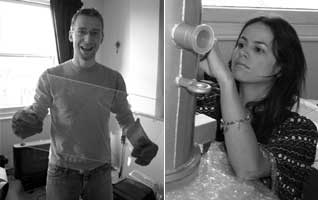 Laura Cinti and Howard Boland’s experiments and artistic projects explore critical and contemporary amalgamations of bio and electronic art. The aim of c-lab, their art/science studio lab, is to produce what the artists call “cultural holes” that allow artistic exploration of meaning and idiosyncrasies that focuses on life – organic, artificial and otherness.
Laura Cinti and Howard Boland’s experiments and artistic projects explore critical and contemporary amalgamations of bio and electronic art. The aim of c-lab, their art/science studio lab, is to produce what the artists call “cultural holes” that allow artistic exploration of meaning and idiosyncrasies that focuses on life – organic, artificial and otherness.
Laura‘s art pieces (in particular her “hairy cactus“) has been featured all over the media. She also works commercially as researcher and interactive designer on art/science projects. Currently she is furthering her practices in bioart through her PhD at University College London. She has a First Class Honours degree in Fine Art and Distinction in MA Interactive Media.
Howard‘s work spans across electronic media and he is currently leading producer and programmer for HSBC global campaign yourpointofview.com. He has degrees both in Mathematics and Software Systems for the Arts and Media. He has Distinction in MA Digital Practices.
Both have lectured and exhibited internationally.
You both seem to have different backgrounds and expertise. How do they complete each other?
Laura comes from a fine art and interactive media background where her works focused on cloning then later genetics. Howard comes from a background in mathematics that later branched into electronic media. We join up through critical theory and a desire to explore works on various forms of ‘otherness’ and adventures in science (and humour).
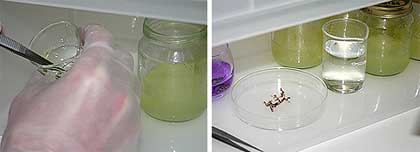 Experiments: Tissue culturing
Experiments: Tissue culturing
What can an artistic approach bring to issues raised by the advances in genetic technology?
This is an interesting question on a broader scale and is actually a critical point in a current online symposium [Virtual Symposium On Visual Culture and Bioscience]. Here, Suzanne Anker prompts the notion that the biosciences may be considered to be experiencing a “golden age,� the arts on the other hand, struggle not with public consumption, but with a more profound challenge to intrinsic identity and history. However, a few examples of what has been raised might be in place, such as Tissue Culture & Art Project, showing the “failure� of the technology (tissue engineering) by playing with utopian concepts by reflecting on technological zeitgeists. Joe Davis, a research fellow at MIT, takes a different route by attempting to use biotechnologies to open spaces between different scales, one such example is his audio microscope another is his paramecium fishing contraption. Artistic approaches can serve to contemplate how the media informs the public on matters of technology, there are also practices that take place in the labs that are being reflected upon by artists and contextualization on what is being produced by labs in broader cultural terms. It is clear to us that organisms produced routinely in labs, methodologies and ideas are far more radical than many of the ideas from the surrealist movement and these practices radically transforms our culture.
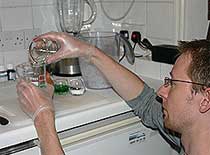
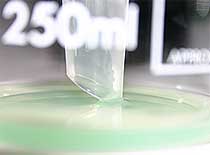 Experiment: DNA extraction
Experiment: DNA extraction
I usually associate biotech art with Australia or the US, how’s the London scene on that regard? Is there a community of artists and researchers with similar interests in London and the rest of the UK?
Your association is completely granted seeing that most radical and important works in the bioart genre is coming from these two countries. The London scene has a different focus and may be divided into two camps which fall slightly outside what we today may associate with bioart. On the one side there is the “communicating science� in artworks which are collaborative projects mostly focusing on the human body and medical imaging technologies and on the other there is the britart movement which follows in the trails of Damien Hirst and the likes. Its variation may also be a result of UK’s more embedded art and design education. Art agencies like the Art Catalyst have in the past brought in artists/researchers working with bioart such as Oron Catts and Steve Kurtz (though more art-activist than bioartist) offering talks and workshops in London. Still it remains a problem that there are no constant body that offers artists to practice in labs. The UK has however had a few practicing bioartists in the past such as Martha De Menezes who worked out of the Imperial College of London. Another issue that may be raised is that funding is now being picked up by scientists to communicate science projects as art – again this falls in under “communicating science� rather than digging into the complexity of contemporary art and theory (knowledge). London bioart scene is still far from hosting environments such as SymbioticA (Australia), MIT (US) and Ectopia (Portugal).
The Cactus Project is probably your most iconic work. Do you feel that the audience and the media understood its meaningfulness? Do you find that people are usually keen on looking beyond the spectacular aspect of an art piece like the Cactus?
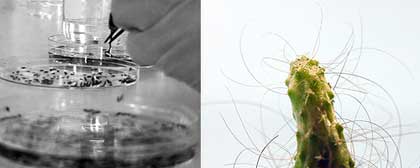 The Cactus Project began in 2001 as a collaborative bioart project resulting in cacti’s expressing human hair. The plants were displayed publicly during a short period (and transported for private views) however the aim was not to generate overt attention, but rather see what happened when a challenging idea hit the culture softly. Genetic engineering – particularly transgenics, may be seen as something anti-sexual or asexual in that its manipulation directly interferes with the natural reproductive process and transfers genetic material from one specie to another. It reverses the sexuality and propagation associated with living entities into something asexual. Transgenesis significance is enmeshed into our existence both presently and in the future.
The Cactus Project began in 2001 as a collaborative bioart project resulting in cacti’s expressing human hair. The plants were displayed publicly during a short period (and transported for private views) however the aim was not to generate overt attention, but rather see what happened when a challenging idea hit the culture softly. Genetic engineering – particularly transgenics, may be seen as something anti-sexual or asexual in that its manipulation directly interferes with the natural reproductive process and transfers genetic material from one specie to another. It reverses the sexuality and propagation associated with living entities into something asexual. Transgenesis significance is enmeshed into our existence both presently and in the future.
Bioart is an alternative exploration that diverge aims conventionally found in disciplines. For me, it is the metamorphosing of an idea into our world, allowing art to become living and part of our communication. The Cactus Project is not just about the scientific output (tools and processes); it’s also to do with the interaction the work has with our culture.
The project has curiously captured a much larger interest from scientists than artists.
Finally it must be mentioned that “the public� or “the publics� are fairly well informed in terms of modern science but unfortunately poorer informed with regards to contemporary art. This can be observed by looking at the amount of analysis and press today’s science receive compared to contemporary art. Also in education, contemporary art forms a smaller section compared to contemporary science.
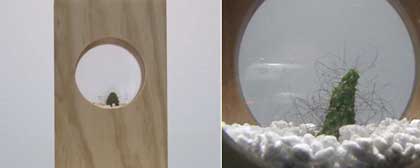 Similarly, do you know how the scientific community approaches your work? What is your relationship with them?
Similarly, do you know how the scientific community approaches your work? What is your relationship with them?
It varies but overall the scientific communities have been the most active audience, perhaps because they have a (surprisingly to me) better layered reading of The Cactus Project than artists.
How do you manage to have access to the technologies you use to develop your works?
Apart from what we can do by ourselves, we try to build relationships and find alliances with scientists but these are not always successful. Before approaching a project we try to establish a good background idea, informing ourselves scientifically as well as artistically and try to understand the research of the people we approach or that approach us. Many of the technologies are unavailable to a general consumer and collaboration is needed. Even if technologies are available the Steve Kurtz case demonstrated the sensitivity around working with these technologies outside specific frameworks.
Can you give us more details about The Mexico Project :: An Ecological Invasion? What motivated your decision to “set them free”? Do you know how the plants are coping over there in the wild?
The project in which two genetically modified cacti were transplanted into two different domains of ‘natures’ inside Mexico was a bio-invasive work whose extensive journey entailed one transplantation in the north amongst its large family of cacti’s and the other in the south of Mexico, Oaxaca, on a hill overlooking its transgenic cousins (the transgenic corn landraces).
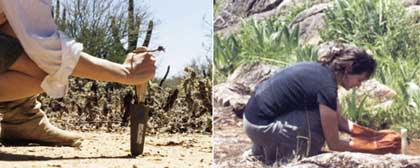 The Mexico Project explores ideas of belonging, constructions of nature and wilderness through releasing novel species. The two transgenic cacti originated from The Cactus Project.
The Mexico Project explores ideas of belonging, constructions of nature and wilderness through releasing novel species. The two transgenic cacti originated from The Cactus Project.
In the first transplantation, the transplantation into the desert, we were seeking the raw pristine nature, the virgin landscape untouched by man. Discourses emerged of wilderness, hybridism, bio-enrichment and belonging.
In wilderness with its pristine-ness and embodied otherness we find nonhumaness – untouched by man. Yet, this otherness’ construction is built by man’s desires and nostalgias, rejecting his own place. In between, the transgenic cactus in all its otherness – is still cactus but touched by man. Part man, part cactus – a new otherness whose semantic orgy – an orgy in nature – penetrates wilderness.
(extract from The Mexico Project pp. 61)
Though the plants are infertile the sexual layered semantics of the journey is part of our reading of the meeting points between the types of ‘nature’ colliding.
The second transplantation intersects stories of GM contamination in an area where local landraces were found contaminated. In a year of poor yield local farmers purchased US imported GM corn (unbeknownst to them) at local discount stores intended for direct food consumption but found they could regenerate these and that these new lavishing plants thrived better than their own – however, surprisingly for one season only. Here enters The Mexico Project into a ‘nature’ amongst domesticated plants genetically ‘contaminated’ both by sexual promiscuity of plants and intervention of man (unintentional and intentional). In the hierarchy of contamination/purity, contamination is rock-bottom; however ideals of ‘nature’ with large ripening fruits and vegetables for the benefits of supporting our ever growing population and bettering our environment through decreased use of chemicals – these ideas are abroad. The transgenic cactus left on a hill in Oaxaca does none of this. It did not need to be created (in terms of the above mentioned regime) but it is there overlooking its transgenic cousins, a non-serving perversion.
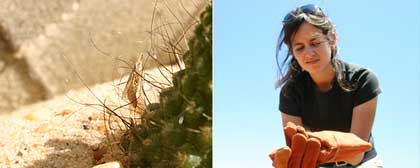
The transgenic cactus was planted. The hole was filled covering the roots of the ‘organic dildo’. Its phallic stem firmly erected and flickering hairs blowing in the wind. Three large butterflies (herbivores) flutters by. They spiral around the cactus and then head for the large white cross, not far away, it’s wonderfully beautiful and resonating, for here is the pristine again, three beautiful butterflies of nature (an aesthetic construction that preserves) but pests in the eyes of agriculture. The fields below hybridizing its Bt toxin immunizing and producing the image of re-resistant butterflies in feedback loops of evolution. The transgenic cactus reminds us of another regime that is less aimed at spiralling into these constructions. In this environment, it is but a dildo.
(extract from The Mexico Project pp. 81)
After arriving back from Mexico, where all thoughts, ideas and manifestations of the project re(in)versed. Setting free from what? Where do they (really) belong? Hence, opening discourses of belonging. This transgression propelled discourses of ‘nature/wild’ as a social narrative rather than the ingrained metanarrative. Hence leading to series of questioning what ‘nature/wild’ is? And with that, it’s being further de(re)miraged by (bio)technological accelerations.
We have not had a chance to visit the cacti. Our thought, ironically perhaps, is that the transplantation in the north (Desierto Sonorense) is perhaps less successful (in the long term due to the harsh weather conditions of the desert) than the transplantation in the south (Oaxaca).
Did you need some special authorisation to transplant them in Mexico? How did it go?
The focus of this work, its legal implications although discussed, lies implicit in the project. The book in particular will help elaborate the many issues we set out to explore. A text only version can be read here.
Are you still working on a “Martian Rose”? Which challenges did you meet while developing the project?
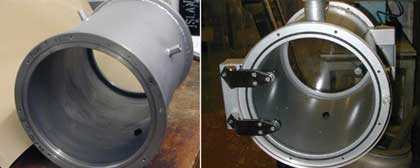 The Martian Rose chamber
The Martian Rose chamber
We are currently working on The Martian Rose. This project will be exhibited in Spain – BIOS4 and UK – Milton Keynes Science Festival – this year.
The initial proposal for The Martian Rose involved genetically engineering a rose for stress tolerance in extreme environment. Part of the research revolves around alienisms, symbolism, ornamentation and culture. Dreaming of a Martian rose is a rather naïve delve into symbolic and perhaps visual imagery, but it doesn’t offer any consolation in terms of beauty – it’s poetic imagery merges with the harsh conditions of its destination (Mars) and the alien is created. The Martian Rose exhibit shows the first part of this research/journey by opening avenues for interaction with a terrestrial rose pre-subjected to proxy Martian parameters.
The Martian Rose attempts to stay within the framework of botany and intends to look at reconstruction of life for extreme conditions which would include the potential aesthetic breakdown through genetic conditioning (i.e. no flowering) as well as carrying a romantic idea of giving a rose for Mars. Discussions around the project led us to reformulate to its future stand – which considers more suitable biological specimens – extremophiles. This is perhaps less romantic but allows us potential habitational environments (ecologies). A proposed avenue is to alter the actual planetary parameters in order to find abstract zones or spaces where life can exist and to investigate what extent this life becomes otherness. As an artistic research the aim is not to produce new scientific knowledge but to open artistic areas in primarily scientific spaces and to address cultural aspects and experiences that also take place. Our overall aim will attempt to explore strategies of engagements, experiences and interactions with live biological specimens within a biochamber initially conditioned to a Martian environment.
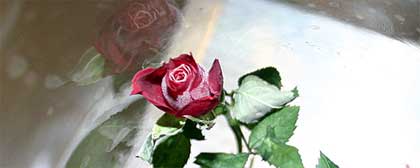
As the project is still in process, we will publish the experiment details (which will take place at the Mars Simulation Laboratory in Denmark) on our site, prior to the exhibitions.
What are you working on these days?
Current projects looks at how our relationship with nature changes through the use of living material as interactive sensors in which the objective involves producing plants with biosensors. It places itself within the artistic discourses surrounding plants perceptual response to mechanical stimuli and explores areas of human-plant interaction and our changed perception though such interaction. It springs out of protocols in producing plants with biosensors and takes into account the narratives that emerge. This research is also part of Laura’s PhD at UCL.
Could you name us 3 “biotech” artists whom you think should get more attention from the public?
There are many bioartists that should get more public attention. For many artists it is difficult to get involved with what remains “unavailable technologies�. Perhaps more than this it is not just the access to the technology but more often the challenge of understanding the processes underlying. You have to align yourself to use it; so it’s an ethical problem and may venture into righteous materialism.
Thanks Laura and Howard!
